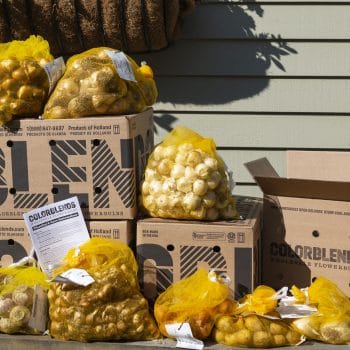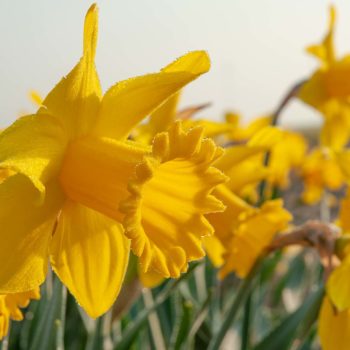Most bulbs do well through Zone 7a in the South. In Zones 7b–10, where soil temperatures do not cool down sufficiently in winter, and spring weather is often very warm, many bulbs perform poorly unless they are prechilled—i.e., refrigerated for 6–12 weeks prior to planting. Here is a rundown of the bulbs we carry and what special treatment they require, if any, to perform well in the Deep South and California.
Don’t know your USDA Zone? Look at any item on this website and click the USDA Zones tab. Then enter your ZIP Code in the Find Your Zone box.
Tulips
Tulips need to be prechilled to bloom well in Zones 7b–10. They should be placed in the refrigerator (not freezer) in October for 6–12 weeks, then planted in December when the weather cools down. Without chilling, plants will be stunted and the flowers will open down in the leaves. Once you take the bulbs out of the fridge, plant them right away. Don’t let the bulbs sit in the sun while you are digging.
In the Deep South (and much of California), tulips should be considered an annual and new ones planted each year. We have lots of southern customers who are comfortable with planting every year, but it is really a budget decision. The tulips on our Bulbs for the South page handle the chilling process and southern heat reasonably well. Some wild tulips can return for several years, namely Bakeri Lilac Wonder, Clusiana, Tubergens Gem, Linifolia, and Tinka.
Daffodils
The daffodils on our Daffodils for the South page do well through Zone 8 and have the ability to come back. They can be planted in November without any prechilling. We don’t recommend daffodils in southern Zones 9 and 10. On the other hand, most daffodils do well through Zone 9 in the West, if given sufficient moisture. Some will even perform well through Zone 10.
Hyacinths
Prechill and plant immediately, like tulips, but don’t expect more than one year of bloom.
Alliums
Most alliums struggle in Zones 8–10 in the South, so we don’t recommend them. Prechilling does not help them cope with southern heat. On the other hand, alliums can perform well all the way through Zone 10 in California.
Amaryllises (Hippeastrum)
Hardy outdoors in Zones 8b and warmer. May be able to survive in 8a in protected locations. Prechilling is not required. Foliage persists through summer and may be present year-round where winters are very mild. A location in partial shade is recommended in the South. Flowering typically occurs in spring.
Blue Squill (Scilla)
Prechilling is required. Persistence beyond the first spring is unlikely.
Camassia
We don’t know a great deal about the performance of Camassia in the South. Our suggestion: prechill the bulbs and test the water before ordering in large numbers. Camassia should perform OK in Northern California (prechilling suggested). It is not recommended in Southern California.
Crocuses
Crocuses need prechilling. They may come back for a few years in Zone 8, then peter out. Tommies (Crocus tommasinianus) are the best return growers in the South.
Crown Imperials (Fritillaria)
We do not recommend these bulbs in the South, prechilled or not. They may perform reasonably well in Northern California with prechilling. They are not recommended for Southern California.
Glory of the Snow (Chionodoxa)
Prechilling recommended. Glory of the Snow is unlikely to be around for more than a year or two in the Deep South.
Grape Hyacinths (Muscari)
We recommend that Grape Hyacinths be prechilled. They may come back for a year or two in Zone 8.
Irises
Bulbous irises, like Iris Harmony, need extended winter cold and collapse quickly if temperatures spike in early spring. Accordingly, we do not recommend them in the South. They may perform as advertised, with prechilling, in Northern California. Not recommended in Southern California.
Paperwhites
It may be possible to grow paperwhites outdoors in the Deep South. There isn’t a lot of good information on this subject. Our guess is Zone 8b and warmer, perhaps as warm as Central Florida. Paperwhites are definitely worth trying outdoors in Southern California.
Snake’s Head (Fritillaria)
Snake’s Head is not recommended for the Deep South, but if you want to try it, prechill before planting. It should do OK in Northern California with prechilling. It is not recommended for Southern California.
Snowdrops (Galanthus)
Snowdrops are not recommended for the Deep South. They may perform well in Northern California but not in Southern California. These bulbs do not need prechilling.
Snowflake (Leucojum)
Snowflake does well in Zones 8 and 9 without special treatment. We don’t recommend it for Zone 10 in the South, but it can do well in Zone 10 in California
Spanish Bluebells (Hyacinthoides)
Spanish Bluebells are a good choice in Zone 8. They don’t need prechilling. We don’t recommend them for Zones 9 and 10 in the South, but they perform well in those Zones in California.
Striped Squill (Puschkinia)
Prechilling is required. Persistence beyond the first spring is unlikely.
Windflowers (Anemone)
Windflowers need prechilling in the South, and may not put on much of a show even then. If prechilled, they can perform well for at least one season in California.
Winter Wolf’s Bane (Eranthis)
Winter Wolf’s Bane is iffy in the South. Prechilling is recommended to increase the chances you’ll get a decent showing the first spring after planting. Can perform well in Northern California. Not recommended for Southern California.


